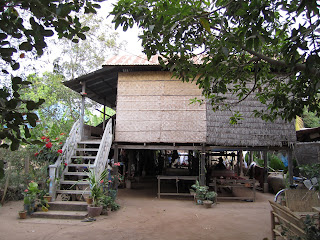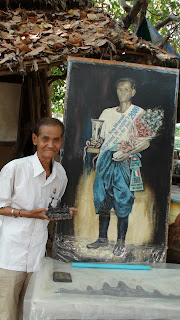 |
| Waiting for Passengers |
Not too long ago, our family participated in a river
excursion with some other embassy workers, both American and Khmer. It was my
first time on the river, and I honestly wasn’t even sure which river I was on!
You see, Phnom Penh is located at the juncture of three rivers: Tonle Sap,
Mekong River, and Tonle Bassac. Tonle Sap flows by the northern part of the
riverfront area. Then, from the perspective of Phnom Penh, the Mekong joins it
partway through the city, coming in at an angle from the northeast. (Of course,
technically, it’s Tonle Sap that joins the Mekong, as the Mekong River is
considered to continue, whereas Tonle Sap ends at that point.) Shortly after
that, Tonle Bassac forks off to the southwest. All that to say: our river
excursion consisted of time spent on Tonle Sap and on the Mekong River.
 |
| Our gangplank and handrail |
Because most of us didn’t know exactly where the boat was
docked, we met up at the embassy and then caravanned over to the riverfront in
a train of tuk-tuks. When we arrived, we walked down a long set of stairs, then
along a dirt path to our boat. There was a wooden gangplank and a thick wooden
staff bridging the distance from the shore to the boat. As we approached, two
Khmer men—one on land and the other on the boat—picked up the staff, and it
became the handrail for our mercifully short trip across the way-too-flexible
gangplank. Due to my natural clumsiness, I had handed Alexa over to Jeff as
soon as I saw the steep stairs, and that jouncing gangplank only strengthened
my confidence in that choice!
Grateful to be on relatively solid footing, I looked around
the boat. It was much larger than the feluccas to which I became accustomed in
Egypt; it was the size of Egyptian “party boats”—our group of 20 to 30 people
didn’t come close to filling it. It had two levels: the upper level was
completely exposed to the sun and had just two tables with chairs for seating;
the lower level was completely shaded (although open on the sides), with a long
table down the middle and wicker chairs and couches along each side. We spent
almost all of our time on the lower level.
Once we all were aboard, we got on our way. Alexa had just
gotten comfortable with the idea of roaming a few feet from us—always under our
careful eye—when the engines turned on. Her eyes widened, and she froze in
place, refusing to lift either foot, while making a noise that sounded a lot
like a higher-pitched version of the engines themselves. We let her stay that
way for only 2 or 3 seconds before we rescued her, picking her up and
reassuring her that all was well. She was fine as soon as she was in our arms,
and shortly thereafter she was willing to get back down.
 |
| Shore--see the water line near the top of the stairs? |
It was nice being on the river. The breeze made it feel a
bit cooler than on land, and even though it’s only March, it’s already hot and
getting hotter. We currently are in the hot-dry (or hot-humid-but-it-just-won’t-rain)
season. The river looks very different from how it looked when we arrived,
toward the end of the rainy season. Then, the river
 |
| Dredging |
was even fuller than it
usually is at that point, because there had been more rain than usual, and
flooding was a serious concern throughout the region. If we’d taken this cruise
when we first arrived, I think we would have avoided at least two-thirds, if
not three-fourths, of the steps we’d taken down from the road.
Before too long, we approached some large ships that were
anchored in the river. It wasn’t clear to me at first what they were doing, but
as we passed them, it became apparent that they were dredging. The confluence
of rivers dumps quite a bit of earth on the riverbed, and that earth must be
removed. I was told that there’s quite a bit of competition for the right to
remove that earth.
 |
| The shore of Koh Dach |
As we passed the dredgers, we rounded a point of land and
moved from Tonle Sap into the Mekong River. We traveled northeast for about 15
kilometers and then stopped at Koh Dach, or Silk Island. The coastline was
studded with occasional houses or sheds floating on the river, and with several
homes built much higher, where the ground leveled out. There were no flat, wide
beaches here—the water lapped against grass and mud that rose steeply for a
good 20 or 30 feet before leveling out.
Unfortunately, there was no place where the boat could dock
level with the ground at all, much less level with the easy ground. This trip
over the gangplank was much more precarious than the first. The deck was a good
5 feet higher than the land. Hence, the gangplank, not being overly long, was
tilted steeply. In order to make it as sturdy as possible, the crew had wedged
it into the muddy bottom, so each passenger did a controlled run down the
plank, then timed their hop/step over or up to dry land before beginning the
trek up to the level sandy paths and dirt roads. I took one look and handed
Alexa back over to her father before I made the run, all the while praying for
grace—both spiritual and physical!
 |
| The silk factory/house |
Finally on level ground, without any unfortunate tumbles, we
walked just a few feet down the road to a traditional Cambodian house. The area
underneath the raised house had been converted into a workshop and store. Four
 |
| Looms |
large looms filled most of the space. Each was threaded with two colors of silk,
one primary color and an accent color of either gold or silver. The primary
colors were a vibrant pink and a rich turquoise, both beautiful. We could see
the traditional pattern emerging with every movement of the weavers. A small
part of the shaded area was set aside as a shop, in which all sorts of silk
goods were for sale: scarves, tablecloths, ties, handbags, stuffed animals,
decorative wall hangings. I didn’t intend to buy anything—we’d not been told that
the excursion would include a stop on Silk Island—so I didn’t ask for any
prices, although some of the others made purchases.
 |
| Silkworm cocoons |
Behind the house there was a shed where silkworms usually
live. I wandered in while the tour was already in progress, so I didn’t catch
the explanation, but there were no worms in evidence. Instead, there were cocoons,
in which the worms presumably were turning into moths. I’m not sure how long
they’ve been in that state or how long they will remain that way.
After our tour of the silk factory, we returned to the boat.
I picked my way down the long, steep hill and then breathed a sigh of relief.
In our absence, the crew had repositioned the gangplank so that it was much
less steeply angled than it had been on our way down. I’m not sure I could have
climbed back up it had they not moved it!
On our way back to the city, a meal was set out. I’m not
sure what anything was, but it was (mostly) good. There was a spicy soup, which
others loved but I hated. There were mild dishes consisting of chicken or beef
with vegetables, which I enjoyed. There was normal rice (very good) and a spicy
lentil-rice dish, which, again, others loved but I hated (are you seeing a
pattern?). Finally, there was some dessert that was absolutely delicious. I don’t
know what it was, but it was sweet, unlike many Asian desserts. It had the
consistency of rice pudding, but it was a dark color and had larger objects—the
size and consistency of grapes, so possibly lychee chunks—mixed in. I should
have taken a picture so I could ask my housekeeper what it was and how to make
it, but I didn’t.
Shortly after dinner was over, we arrived back at the
docking area, barely ahead of the lightning that had been illuminating the dark
sky for the last half hour or so. The wind was severe and felt dangerous; the
crew actually had tried to get us offloaded sooner by docking farther south
than where we’d boarded, but they decided that the ground was too muddy and we
wouldn’t be able to walk from the boat to the nearby stairs. We ended up just
one in a long line of boats moving quickly toward the docking area and rapidly
offloading passengers, who scurried to the road and the waiting tuk tuks. It
began to rain before we made it home, but didn’t get heavy until we were
inside. So much for humid-but-it-just-won’t-rain!





















